|
|
Camp
Oldebroek
-
Military and civilian Belgian refugees 1914 - 1918
|
|
After the siege of Antwerp on 7
October 1914 hundreds of thousands of refugees fled to The
Netherlands. Among these were approximately 40,000 mainly
Belgian military men. As soon as they set foot on Dutch soil
they were immediately disarmed and interned, following the
country's neutrality treaty. They were taken to empty
barracks in Amersfoort and Harderwijk and other camps. The
barracks were much too small to accommodate these large
numbers of soldiers, which led to housing and hygiene
troubles.
To try and solve these problems tents were erected, although
as winter was coming, this was only a temporary solution.
Additionally, in smaller towns -think of: Leeuwarden, Assen,
Zwolle, Kampen and Loosduinen- there was an enormous number
of Belgian troops causing problems accordingly. The then
Minister of War, Bosboom, ordered the construction of
special camps near Zeist, Harderwijk and Oldebroek, which
had to accommodate respectively 13,500, 11,500 and 3,500
interned.
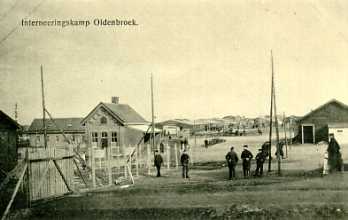 |
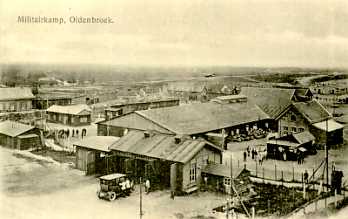 |
Entrance gate of Camp Oldebroek |
A view of Camp Oldebroek |
In January 1915 camp Oldebroek was ready to receive 1,200 Belgian
military men from the barracks of Leeuwarden and 2,300 Belgians from Assen.
The provisionary internment camps in Leeuwarden and Assen could therefore be
closed down. The total number of inhabitants of camp Oldebroek was 24
officers, 2 chaplains and 3,485 privates. The Belgian reserve-colonel
Bernelot Moens was charged with the command of the camp.
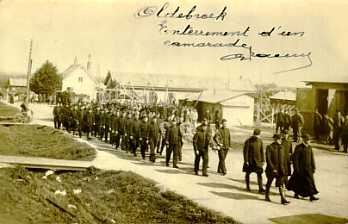 |
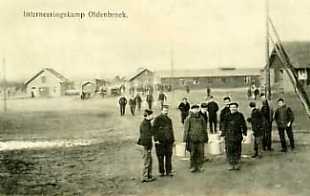 |
Funeral in the Camp |
One of the camp streetsin Camp Oldebroek |
The camp was made up of 17 barracks of which two were designed for non-commissioned
officers. There was a canteen, school barracks and a library. Oldebroek housed the
artillery school (Artillerie Schietschool) of the Dutch army and the camp could use its
facilities. For example an infirmary. There were also two music-bands for
relaxation.
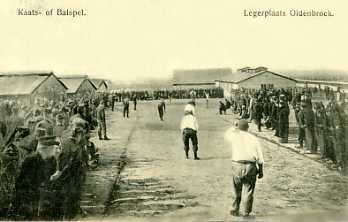 |
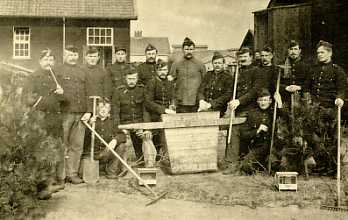 |
A game of fives in the Camp |
A snapshot of the occupants of the Jordaensbarracks |
Because of employment outside of the camp and many mutations the number of interned in
the camp shrank. On 30 June 1916 there were only 2,734 people left. At the same time the
Dutch government tried to economize and the artillery school felt hindered in its actions
by the Belgians. This is why it was decided to close down the camp.
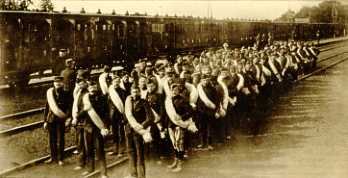 |
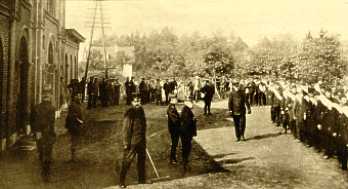 |
Leaving of Belgian internees from Camp
Oldebroek to Camp Harderwijk in June 1916 |
At the end of July 1916 1,859 interned left for Camp Harderwijk. The others remained in
Oldebroek as an internment group because they had found jobs in the area. On 1 September
1916 camp Oldebroek was officially closed down.
Women's village Moensdorp
['dorp' meaning village]
Many married Belgian military men were followed by their families who had fled to the
Netherlands as well. Originally these families rented rooms in the immediate surroundings
of the internment camps. However, this led to unwanted pushing of room prices and many
families were in danger of remaining without income. This is why the so-called women's
villages were built near the internment camps. Here the families could be accommodated and
if needed financially supported.
In the immediate surroundings of Camp Oldebroek Moensdorp
was built. The women’s camp was built on the road, which led from the railway station
to the artillery school. It was named after the Belgian commander of the camp. Moensdorp
existed of five barracks of each 20 rooms, 4 private buildings and a
coal-shed.
The Dutch
government was charged with the construction costs and these amounted to fl. 42,866.44.
The government owned the ground and did not have to lease or buy it. The artillery school
provided the water supply and opened up their bathhouse and hospital. Camp Oldebroek
supplied electricity. The children were educated in the six camp school buildings,
consisting of eleven classes.
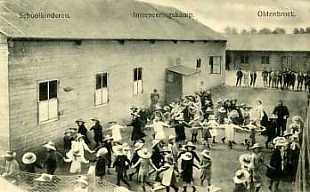 |
The school in Camp Oldebroek |
Moensdorp was built with the help of the interned military men of Camp
Oldebroek. With the closing down of Camp Oldebroek in the summer of 1916 and the transfer
to Harderwijk, Moensdorp was transferred entirely to Harderwijk as well. There it was
added to the women’s camp Heidekamp, which now counted 200 families. This transfer
was entirely executed by Belgian interned.
Refugee Camp Oldebroek
Encampment Oldebroek had been used before to accommodate especially poor refugees
who could not find housing in the province of Limburg with the outbreak of war in August
1914. In September 1914 there were already 1,100 refugees received. Refugees that were
still there at the beginning of 1915 were accommodated at refugee Camp Nunspeet
(Vluchtoord Nunspeet).
The refugee Camps Nunspeet, Ede and Uden were built by the Dutch government to
accommodate poor Belgian refugees who could not or would not return to their home towns
and received financial aid from the Dutch government. (Cf.:
civilian refugees in the Netherlands 1914
– 1918).
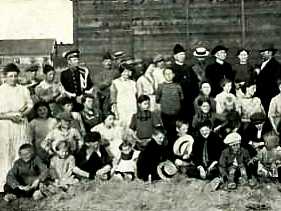 |
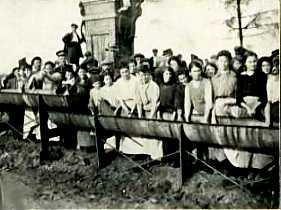 |
Refugees from Mouland and Fouron de Comte
(Belgium) with their priest (September 1914) |
Horses' water-troughs now used as
hughe washtubs |
As early as 17 September 1914 a delegation of the provincial committee
of Groningen, which supported Belgian and other refugees (provinciaal Groningse Comité
tot steun Van Belgische en andere vluchtelingen), visited the refugee Camp
Oldebroek. The
committee had collected money and clothing and wanted to know where help was needed most.
The delegation visited Camp Oldebroek as well, but did not feel very welcome. An account
of the visit:
"We were admitted to the canteen where we were put in a corner. We sat there like
good children watching the appetite of Commissioner Hendrik Muller Ph.D. and his staff
(…). Then we were admitted to the chief’s office. We asked: "What can we
do?" and were answered: "Nothing. The government maintains them. We don’t
need money, have plenty of clothes and", the commissioner continued with a
smile,
"God forbid we would get more blouses." "Is there really nothing we can
do?" was our humble question. The answer was: "Well yes, if the committee wants
to do something, let it send us a bowling game for the men. We will have them build a shed
for it and provide the gentlemen with something to do in their spare-time."
The Camp was not on view; it was closed to all unnecessary visitors. "And for that
matter, what is there to see?" remarked Muller Ph.D., "large sheds and stables
full of wretched creatures. Don’t you for a minute believe that this camp consists of
anything else." Most inhabitants of the camp were the poorest from the border
towns;
more civilized or has-been- well off people suitable for housing with families don’t
stay here. There are troublemakers and dangerous people here: they who had to be removed
from our borders out of necessity. This made protection and management of the camp
stricter than any other camp the committee visited afterwards.
"A hearty handshake by Muller Ph.D. and a cheeky
"charming, your visit, charming" from his lips and
we were out of the camp as fast as we had entered it
(…)".
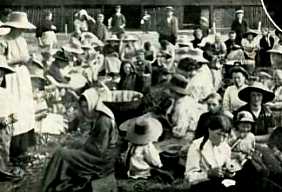 |
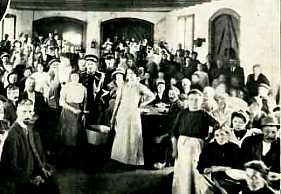 |
|
Belgian women peeling
potatoes |
The central dining-room
during the midday meal |
From the account of the committee it further becomes
clear that to relieve the need of the camp an amount of fl.
250,- was send to Oldebroek with 13 boxes of clothing and
the requested bowling game.
Literature:
H. Brugmans – Nederland in den oorlogstijd
J. Kooiman – De Nederlandse strijdmacht en hare
mobilisatie
Verslag van de werkzaamheden der Centrale Commissie
Verslag van het provinciaal Comité tot steun van Belgische
en andere vluchtelingen te Groningen.
|
|
|